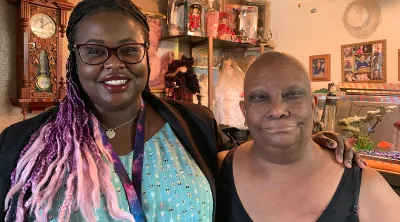Standardized screening for social determinants of health means holistic healthcare from the first appointment

A personal health advocate works with a primary care team to help an overwhelmed patient face multiple illnesses and address social determinants of health.
Mounting diagnoses led to rising stress
For J.P. Sullivan, a grandmother of seven in Lancaster, California, one health problem just followed another.
A few years ago, doctors told her she had undiagnosed high blood pressure. Then came congestive heart failure. Next, stage two breast cancer. But, sitting at the kitchen table in her small condo, Sullivan is still smiling, even though she has more radiation therapy ahead of her. That’s partly because her personal health advocate, Stephanie Johannesmeyer, is here too.
“She’s here for me so I don’t have to do all of it,” says Sullivan, referring to Johannesmeyer’s role in helping her manage life with complex health problems outside the doctor’s office. Sullivan has multiple health conditions, an array of doctor appointments with different specialists, multiple medications to manage and family caregivers who aren’t always available to help her. The stress has piled up. She remembers a time after breast cancer surgery when her pain became too much to bear. She called the clinic for a refill on medication but was told the approval would take a few days. She lacked the strength to wait, so she called Johannesmeyer.
“Stephanie got that pre-approval for me the exact same day and called me a couple of hours later. She said, ‘You can pick your medicine up any time after five o’clock.’”
Systematic screening for social determinants of health helps providers build a plan to address them
Sullivan is a patient at one of Blue Shield of California’s two clinics in Southern California, where the health plan is piloting a new model. Patients are formally screened, not just for physical or mental health conditions such as diabetes or depression, but also for other factors that might affect their health, such as a lack of transportation or food insecurity. Recent studies estimate that these kinds of social determinants of health, which can also include a lack of basic resources, low income, and a lack of knowledge about the healthcare system can be responsible for up to 80% of health outcomes.
But increasingly, health insurers and doctors are addressing them. The information Blue Shield of California’s clinics uncover during the initial screening for social determinants goes into the patient’s electronic medical record, providing clinicians a full picture of their needs and the ability to track and address them.
“Doctors know what to do when a patient comes in with a blood pressure reading of 180 over 120,” says Dr. Chris Esguerra, a Blue Shield of California medical director and a visionary behind the program. “They aren’t necessarily equipped to help a patient who tells them, ‘I don't have enough food to last me for the week and I don't know if I can actually manage my own blood sugar.”
Health advocates for patients, part of the clinical team
That, says Esguerra, is where health advocates come in. They’re members of the clinical team. They join each morning’s huddle to talk about patients scheduled for the day. After that huddle, Johannesmeyer says she can then check a patient’s record for any concerns and even prepare to visit the exam room and introduce herself.
“I give them a little rundown of what type of things we'd be able to assist them with,” says Johannesmeyer. If they’re interested, she makes an appointment to visit the patient’s home (or determines quickly how to find housing if the patient is homeless). She can assess the safety of a patient’s home, check the fridge, even look for signs of domestic abuse. Those are things, says Johannesmeyer, “patients might be embarrassed about mentioning in a doctor’s office.” But once she has identified a need, she can offer solutions. Johannesmeyer says she’s seen those solutions go a long way toward improving a patient’s health.
Watch how this health advocate helped Jose Herrera live a better life
The model is paying off in healthier patients and lower costs
Esguerra says the model is paying off not only in terms of improved health and quality of life for patients, but avoided healthcare costs. Patients are better able, and more willing, to come to the clinic for care, which means they’re not delaying care and letting health conditions worsen.
“That means they're not as likely to have to go to the hospital. They're not as likely to have to go to the emergency room,” says Esguerra. “And so instead of going to those higher-cost settings, they come to the clinic.”
That’s huge in the Southern California locations where Blue Shield of California has chosen to pilot the model. Lancaster has one of the state’s highest rates of emergency room visits.
“That’s why we're tackling things way more upstream,” says Esguerra, removing barriers to good health one patient at a time.
Blue Shield of California is an independent licensee of the Blue Cross Blue Shield Association, an association of independent, locally operated Blue Cross and Blue Shield companies.
